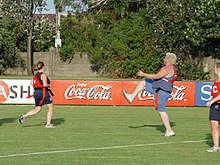Variations of Australian rules football
They range in player numbers from 2 (in the case of kick-to-kick) up to the minimum 38 required for a full Australian rules football.
Other variations include children's games, contests or activities intended to help the player practice or reinforce skills, which may or may not have a competitive aspect.
Most of the variations are played in informal settings, without the presence of umpires and sometimes without strict adherence to official game rules.
Auskick is a program developed in Australia in the 1980s and promote participation in Australian rules football amongst children, particularly of primary school age and under.
Auskick has its roots in the Little League which began to be played at half time during VFL matches in the 1960s[2] and was revised in 1980 to make it more accessible.
Little League was expanded by Ray Allsop into a state development program called Vickick begun in Victoria in 1985.
Urged by former player David Parkin in 1995 as a means of keeping the sport viable long term in the Australian Capital Territory[3] it was adopted by the AFL Commission the national governing body for the sport, which began to roll it out nationally from 1998.
Women's Australian rules football is a fast-growing variation played by all-female teams that dates back to the 1910s.
The women's game is also a contact sport, however over the course of its history it is sometimes played with modified rules including different player numbers (16 a side + 5 interchange), a smaller ball, and increased tackling restrictions.
Masters Australian Football (also known as "Superules" or derisively as "Superfools") is an amateur social variation for players aged 35 years and over.
Lightning matches are often used, particularly at junior or amateur level, to play an entire tournament inside a single day or weekend.
Examples of official tournaments held under these rules include the EU Cup and Bali Nines.
Unlike Australian rules football, player movement is restricted to zones (similarly to Rec Footy).
The reasons for the development of Metro Footy was partly due to there being few grounds large enough for traditional Australian rules matches, but also to allow competitive football to be played with smaller playing numbers, allowing for better recruitment possibilities.
The teams that play feed into larger 18-a-side Australian rules representative teams that participate in leagues such as the MAAFL or tournaments such as the USAFL National Championships and also provide the opportunity to introduce new American players to the game of Australian rules football.
[citation needed] Several clubs from the United States Australian Football League participate in Metro Footy.
[14] The game uses a regular Australian rules football and is played on a confined square court with the goals on opposing diagonals.
The ball must not touch the ground, marking is protected by a drop-zone and only designated forwards can kick goals.
AFL 9s offers mixed, as well as all-male and all-female, competitions to lower the barriers to entry for participation; according to official rules, mixed-gendered games award 9 points to goals scored by female forwards, three more points than all other forwards.
[17] As a recreational game AFL 9s has proved popular with both new and established Australian rules players with 24,032 participants in Australia in 2019 at least a third of which are female.
Rec Footy was heavily criticised mainly by Australian rules players for appearing similar to netball, too restrictive on movement by enforcing strict zones and field positions, penalising athletes and reducing fitness benefits, lacking the ability for skilled footballers to use skills like bouncing and long kicking and play naturally whilst also penalising newer unskilled players with frequent turnovers.
Although not a sport in itself, the term is used to describe a social exercise played in parks, fields, streets and back yards, and requires at least two people.
Austus is a sport which was started in Australia during World War II when United States soldiers wanted to play football against the Australians.
First codified in 1914, the game was originally designed to be played by teams of 15 on rectangular fields with rugby-style goalposts featuring a crossbar.





